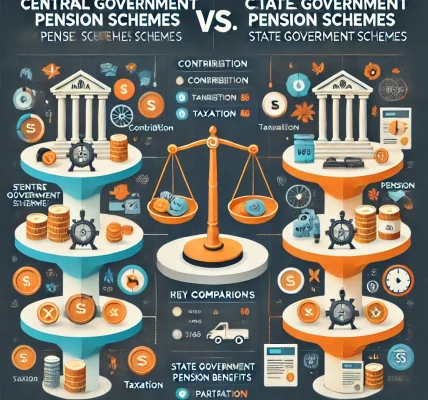Introduction
Retirement planning is crucial to ensure financial security in old age, and government pension schemes play a significant role in supporting individuals post-retirement. While the central government offers various pension schemes, many Indian states have introduced their own pension plans tailored to specific demographics such as senior citizens, farmers, widows, and unorganized workers. In this blog, we explore the various state-wise pension schemes in India and help you determine which one suits you best.
Why State-Wise Pension Schemes Matter
Although central pension schemes like the National Pension System (NPS) and Employees’ Provident Fund (EPF) are widely recognized, state-wise pension schemes provide additional benefits. They are often designed to cater to local populations, offering targeted financial assistance to residents based on their socio-economic status. Here are some key advantages of state pension schemes:
- Additional Financial Support: Complements national pension schemes to provide enhanced security.
- Tailored Benefits: Specific to the needs of different communities and professions.
- Easy Accessibility: Managed at the state level, making application and disbursal processes smoother.
State-Wise Pension Schemes in India
1. Andhra Pradesh – YSR Pension Kanuka
- Provides pensions to elderly individuals, widows, disabled persons, weavers, and transgenders.
- Monthly pension varies between ₹2,250 and ₹10,000, depending on the category.
2. Bihar – Mukhyamantri Vridhjan Pension Yojana
- Offers a monthly pension of ₹400 for people aged 60-79 years and ₹500 for those above 80 years.
- Available to senior citizens who are not receiving any other government pension.
3. Delhi – Old Age Pension Scheme
- Provides financial assistance of up to ₹2,500 per month to senior citizens with low income.
- Beneficiaries must have a valid residence proof of Delhi.
4. Gujarat – Vidhwa Sahay Yojana (Widow Pension Scheme)
- Offers ₹1,250 per month to widowed women to support their financial stability.
- Must be a permanent resident of Gujarat and fall under the Below Poverty Line (BPL) category.
5. Karnataka – Sandhya Suraksha Yojana
- Grants ₹1,000 per month to senior citizens below the poverty line.
- Additional benefits include free bus travel and subsidized medical care.
6. Maharashtra – Sanjay Gandhi Niradhar Anudan Yojana
- Provides ₹600 per month for individuals and ₹900 for families.
- Applicable to destitute individuals, disabled persons, and widows.
7. Rajasthan – Mukhyamantri Vridhjan Samman Pension Yojana
- Offers ₹750 per month for individuals aged 60-75 years and ₹1,000 for those above 75.
- Targeted towards economically weaker sections.
8. Tamil Nadu – Indira Gandhi National Old Age Pension Scheme (IGNOAPS)
- Senior citizens above 60 years receive ₹1,000 per month.
- The scheme benefits individuals belonging to BPL families.
9. Uttar Pradesh – Rashtriya Vyoshree Yojana
- Aimed at providing medical aids and financial assistance to elderly individuals.
- Provides free assistive devices such as hearing aids, spectacles, and walking sticks.
10. West Bengal – Jai Bangla Pension Scheme
- Provides ₹1,000 per month to senior citizens under the Taposili Bandhu scheme and ₹600 under the Manabik scheme.
- Designed for elderly and physically challenged individuals.
How to Choose the Right Pension Scheme?
Choosing the right pension scheme depends on various factors, including:
- Age & Eligibility Criteria: Different states have different eligibility conditions, such as age limits and income requirements.
- Monthly Pension Amount: Compare the pension amounts offered by various states to determine which provides better financial support.
- Additional Benefits: Some pension schemes provide medical benefits, transport subsidies, and other perks.
- Application Process: Opt for schemes that offer easy digital access and hassle-free documentation.
How to Apply for State Pension Schemes?
The application process varies by state but generally includes the following steps:
- Check Eligibility: Visit the official state government website to verify the criteria.
- Gather Required Documents: Typically includes Aadhaar card, income certificate, domicile proof, and bank details.
- Online/Offline Application: Some states provide an online application process through state e-governance portals, while others require submission at government offices.
- Verification & Approval: The authorities review applications and verify details before approval.
- Receive Pension Benefits: Once approved, pension payments are transferred directly to the beneficiary’s bank account.
Challenges & Future of State Pension Schemes
Despite the benefits, state-wise pension schemes face several challenges:
- Delayed Disbursements: Some states experience delays in fund allocation.
- Lack of Awareness: Many eligible individuals remain unaware of their entitlements.
- Complex Paperwork: Manual documentation and verification can slow down the process.
To overcome these challenges, governments are increasingly digitizing pension schemes and incorporating technologies like Direct Benefit Transfer (DBT) and biometric authentication for better accessibility.
Conclusion
State-wise pension schemes provide critical financial support to different sections of society, ensuring a dignified post-retirement life. Understanding the benefits and eligibility of these schemes can help you choose the best option for your needs. If you are eligible for a pension scheme in your state, apply today and secure your future!




